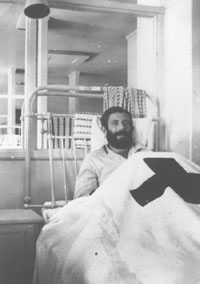


RAAF Meteorological Service
Foreword
Introduction
Chapter 1: The Weather Factor in Warfare
Chapter 2: Establishing and Developing the RAAF Directorate of Met. Services (D.Met.S)
Chapter 3: Recruiting and Training of Personnel
Chapter 4: Meteorology in Aviation
Chapter 5: The Met. Retreating
Papua New Guinea and New Britain
The Netherlands East Indies and Malaya
Escape from Timor
Northern Australia—1942
Chapter 6: The Met. Advancing
Chapter 7: The Met With the Army and the Navy
Chapter 8: Divisional Offices of the Bureau of Meteorology During the War
Chapter 9: Research and Instrumental Development
Chapter 10: The End, Aftermath, and Beyond
Appendix 1
Appendix 2
Appendix 3
Appendix 4
References
Index
Search
Help
Contact us

Escape from Timor (continued)
The disembarkation of the rescued men landing at Fremantle must have been an unforgettable sight. Most of them were emaciated; the sickest could not speak, could barely breathe. They had to be strapped on specially contrived stretchers and hauled up vertically through the hatchways of Sea Raven. Most had long, straggling beards. Rofe, pale and thin, was the only Australian man on deck as the submarine nosed towards the jetty.
In hospital, back in Australia, the 33 men began to recover from their ordeal.
'Those Aussies were grand', one of the US officers told Peter Batten. 'They'd been through hell for weeks, they were as weak as babes. But when they learned that the ship was afire, did they get panicky? Not a bit of it! The few who could stand up properly asked if they could do anything to lend a hand; seemed kind of disappointed when we told them everything was O.K.'
Cassedy and Cook were each awarded the US Navy Cross; McGrievy and Markeson were promoted. Bryan Rofe and his second-in-command, Flight-Lieutenant Arthur Cole, were awarded the MBE. Corporal Leslie Roy Borgelt of Nhill, Victoria, was awarded the BEM. Rofe was full of praise for Cole and Borgelt, but spoke of all his 'Men of Timor' in glowing terms. Pilot-Officer V. C. Leithhead later lost his life while serving with 31 Squadron RAAF.
The Dutch who administered and controlled the Netherlands East Indies before the war were demoralised, as were the other Allies at this stage, by the speed of the Japanese advance, and the ravages of diseases—particularly dysentery—which caused more casualties than the fighting.
In the circumstances, Met. personnel found it almost impossible to give forecasts. Nevertheless, a great deal of initiative was displayed in these forward areas. George Mackey found an old AR7 wireless receiver with which his party was able, intermittently, to pick up PLO Bandoeng—the regional forecasting station. Otherwise, the only weather reports available were a few from bomber aircraft on missions.
People in Bright Sparcs - Mackey, George William; Rofe, Bryan
 |
Bureau of Meteorology |  |
© Online Edition Australian Science and Technology Heritage Centre and Bureau of Meteorology 2001
Published by Australian Science and Technology Heritage Centre, using the Web Academic Resource Publisher
http://www.austehc.unimelb.edu.au/fam/0277.html